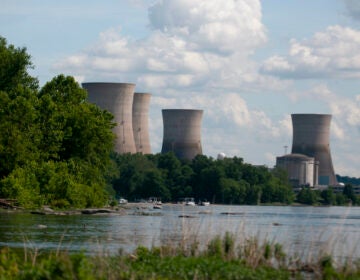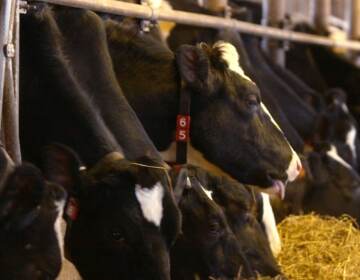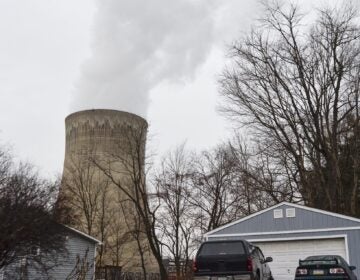Climate focus intensifies in Harrisburg, as budget negotiations and citizen-led petition advance
Parallel efforts to limit greenhouse gas emissions in Pennsylvania — a citizen climate petition and a provision in the state budget — are topics of discussion in Harrisburg.

Calpine's York 2 Energy Center is an 828 megawatt combined-cycle natural gas-fired power plant in York County, Pa. (Marie Cusick/StateImpact Pennsylvania)
This article originally appeared on StateImpact Pennsylvania.
—
Parallel efforts to limit greenhouse gas emissions in Pennsylvania — a citizen climate petition and a provision in the state budget — are topics of discussion in Harrisburg.
The Associated Press reported Tuesday that Gov. Tom Wolf is asking the Republican-led legislature to include language in the state budget, which is expected to pass this month, giving authorization for the Regional Greenhouse Gas Initiative (RGGI) — a consortium among Northeastern states that requires polluters to pay for their emissions. House Republican spokesman Mike Straub said the proposal is being reviewed, along with a “number of ideas” as part of budget negotiations. A spokeswoman for the Senate GOP did not respond to a request for comment.
At the same time, the state Department of Environmental Protection is studying a citizen-led climate petition that would create an economy-wide cap-and-trade program, modeled on an existing one on California. Wolf has called climate change one of the “biggest issues” the state faces. The sentiment was echoed Tuesday by DEP Secretary Patrick McDonnell.
“Going through this petition is one of the components we’re taking very seriously in evaluating how we address climate change,” McDonnell said.
The department plans to issue requests for proposals, seeking a contractor to model how the proposal would affect Pennsylvania’s environment, economy, and society. The agency’s Environmental Quality Board voted in April to advance the petition, which was filed late last year by nearly 200 entities, including municipal governments, faith-based organizations, renewable energy companies, and climate researchers. The emissions cap would start with a budget, assuming a 3 percent reduction from 2016. After that, the cap would be reduced by 3 percent a year and hit net zero by 2052.
McDonnell expects the DEP to receive the emissions report back in early 2020. He said if the department decides to move ahead with the rulemaking process for the cap-and-trade proposal, it would take at least another two years, given the required vetting process for new regulations in Pennsylvania — which includes approval from an independent commission.
If Republicans go along with Wolf’s budget request, it could be a faster way for the state to begin reducing its emissions. Both RGGI and the citizen petition are cap-and-trade programs, but RGGI is more limited because it applies only to emissions from power plants. The petition covers emissions from a broader swath of the economy, including manufacturing and transportation.
Scientists say governments around the world need to quickly and dramatically cut greenhouse gas emissions to keep global warming below 1.5 degrees Celsius — a threshold seen as necessary to avoid the worst effects of climate change, including extreme weather, droughts, and food shortages.
Among states, Pennsylvania is the fourth-biggest carbon polluter. The state is already experiencing climate-related impacts, including increased precipitation.
WHYY is your source for fact-based, in-depth journalism and information. As a nonprofit organization, we rely on financial support from readers like you. Please give today.




